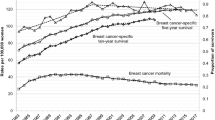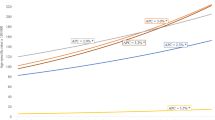Abstract
This study investigated associations of degree of spread at diagnosis of breast cancer and socio-demographic factors with the risk of death among NSW females diagnosed in 1980–2003. Trends by diagnostic period, socio-demographic differences, and the implications for cancer control were considered. NSW Central Cancer Registry data were analyzed using regression and rank-order tests to show predictors of death from breast cancer and trends in degree of spread. Compared with localized disease, case fatality was thrice and 14 times higher for cancers with regional spread and distant metastases, respectively. After adjusting for degree of spread and socio-demographic differences, the relative risk of death from breast cancer has declined in recent diagnostic periods compared with the 1980–1983 baseline, reaching a low of 0.38 (0.35, 0.40) for 1999–2003. Age-specific analyses indicated that relative risks were lower in 1999–2003 for 50–69 year olds (RR = 0.31) than younger (RR = 0.40), or older (RR = 0.46) females. Regional or distant disease at diagnosis was lowest in the older age groups, the highest socio-economic stratum and in more recent periods. Females born in nonEnglish speaking countries presented with more advanced disease, as did metropolitan women with the highest access to health services. Degree of spread of cancer at diagnosis is a powerful predictor of case fatality. Case fatalities from breast cancer have declined by diagnostic period, after adjusting for degree of spread, which may reflect treatment and screening advances. Attention should be directed at reducing disparities by socio-economic status and encouraging migrant women to present earlier.
Similar content being viewed by others
References
Australian Institute of Health and Welfare & National Breast Cancer Centre (2006) Breast Cancer in Australia: an overview, 2006. Canberra: AIHW, Cancer Series no. 34, cat no. CAN 29
Benson JR, Weaver DL, Mittra I, Hayashi M (2003) The TNM staging system and breast cancer. Lancet Oncol 4:56–60. doi:10.1016/S1470-2045(03) 00961-6
Bland K, Menck H, Scott-Conner C, Morrow M, Winchester DJ, Winchester DP (1998) The National Cancer Data Base 10-year srvey of breast carcinoma treatment at hospitals in the United States. Cancer 83:1262–1273. doi:10.1002/(SICI)1097-0142(19980915)83:6≤1262::AID-CNCR28≥3.0.CO;2-2
South Australian Cancer Registry (2000) Epidemiology of cancer in South Australia. Incidence, mortality and survival, 1977 to 1999. Incidence and mortality, 1999. Openbook Publishers, Adelaide, p 129
Demissie K, Mills OF, Rhoads GG (1998) Empirical comparison of the results of randomised controlled trials and case-control studies in evaluating the effectiveness of screening mammography. J Clin Epidemiol 51:81–91. doi:10.1016/S0895-4356(97) 00243-6
Shapiro S, Venet W, Strax P, Venet L, Roeser R (1985) Selection, follow-up and analysis in the health insurance plan study: a randomised trial with breast cancer screening. Natl Cancer Inst Monogr 67:65–74
Andersson I, Aspegren K, Janzon L, Landberg T, Lindholm K, Linell F, Ljungberg O, Ranstam J, Sigfusson B (1988) Mammographic screening and mortality from breast cancer: the Malmo mammographic screening trial. BMJ 297:943–948
Tabar L, Fagerberg G, Duffy S, Day N, Gas A, Grontoft O (1992) Update of the Swedish two county program of mammographic screening for breast cancer. Radiol Clin North Am 30:187–210
Roberts MM, Alexander FE, Anderson TJ, Chetty U, Donnan PT, Forrest P, Hepburn W, Huggins A, Kirkpatrick AE, Lamb J et al (1990) Edinburgh trial of screening for breast cancer: mortality at seven years. Lancet 335:241–246. doi:10.1016/0140-6736(90) 90066-E
Miller AB, Baines CJ, To T, Wall C (1992) Canadian National Breast Screening Study, 1: breast cancer detection and death rates among women aged 40 to 49 years. CMAJ 147:1459–1476
Miller AB, Baines CJ, To T, Wall C (1992) Canadian National Breast Screening Study, 2: breast cancer detection and death rates among women aged 50 to 59 years. CMAJ 147:1477–1488
Frisell J, Eklund G, Hellstrom L, Lidbrink E, Rutqvist LE, Somell A (1991) Randomized study of mammography screening: preliminary report on mortality in the Stockholm trial. Breast Cancer Res Treat 18:49–56. doi:10.1007/BF01975443
Nystrom L, Rutqvist LE, Wall S, Lindgren A, Lindqvist MJ, Ryden S, Andersson I, Bjurstam N, Fagerberg G, Frisell J et al (1993) Breast cancer screening with mammography: overview of Swedish randomised trials. Lancet 341:973–978. doi:10.1016/0140-6736(93) 91067-V
International Agency for Research on Cancer (IARC) (2002) Press Release No. 139. Mammography can reduce deaths from breast cancer. March 19th
Gabe R, Duffy SW (2005) Evaluation of service screening mammography in practice: the impact on breast cancer mortality. Ann Oncol 16(Suppl 2):ii153–ii162. doi:10.1093/annonc/mdi718
Taylor R, Morrell S, Estoesta J, Brassil A (2004) Mammography screening and breast cancer mortality in New South Wales, Australia. Cancer Causes Control 15:543–550. doi:10.1023/B:CACO.0000036153.95908.f2
MacLennan R (1987) A national cancer prevention policy for Australia, vol vol 1. Australian Cancer Society, Sydney
Australian Health Ministers Advisory Council, Breast Cancer Screening Evaluation Steering Committee (1990) Breast cancer screening in Australia: future directions. Canberra: Australian Institute of Health, cancer series no. 1
The Australian Institute of Health and Welfare & the Australian Government of Health and Ageing for the BreastScreen Australia Program (2006) BreastScreen Australia monitoring report 2002–2003. Canberra: Australian Institute of Health and Welfare, Cancer Series no.32, cat. no. CAN 27
National Health and Medical Research Council (1995) The management of early breast cancer. Clinical practice guidelines. National Health and Medical Research Council, Canberra
National Breast Cancer Centre (2004) Clinical practice guidelines for the management and support of younger women with breast cancer. Australian Government and National Health and Medical Research Council, Canberra
Malycha P, Tyson S (2000) National breast surgery audit. Aust NZ J Surg 70:834–836. doi:10.1046/j.1440-1622.2000.02002.x
Boult M, Cuncins-Hearn A, Tyson S, Kollias J, Babidge W, Maddern G (2005) National breast cancer audit: establishing a web-based data system. ANZ J Surg 75:844–847. doi:10.1111/j.1445-2197.2005.03547.x
Cuncins-Hearn A, Boult M, Babidge W, Zorbas H, Villanueva EV, Evans A, Oliver D, Kollias J, Reeve T, Maddern G (2006) National breast cancer audit: overview of invasive breast cancer management. ANZ J Surg 76:745–750. doi:10.1111/j.1445-2197.2006.03846.x
Paci E, Ponti A, Zappa M, Patriarca S, Falini P, Delmastro G, Bianchi S, Sapino A, Vezzosi V, Senore C, Crocetti E, Frigerio A, Zanetti R, Det Turco MR, Segnan N (2005) Early diagnosis, not differential treatment, explains better survival in service screening. Eur J Cancer 41:2728–2734. doi:10.1016/j.ejca.2005.06.026
Yu X, O’Connell D, Gibberd R, Coates AS, Armstrong BK (2006) Trends in survival and excess risk of death after diagnosis of cancer in 1980–1996 in New South Wales, Australia. Int J Cancer 119:894–900. doi:10.1002/ijc.21909
Tracey EA, Chen S, Baker D, Bishop J, Jelfs P (2006) Cancer in New South Wales: Incidence and mortality 2004: Sydney: Cancer Institute NSW
Ries LAG, Harkins D, Krapcho M, Mariotta A, Miller BA, Feuer EJ, Clegg L, Eisner MP, Horner MJ, Howlader N, Hatat M, Hankey BF, Edwards BK (eds) (2006) SEER Cancer Statistics Review, 1975–2003. National Cancer Institute, Bethesda MD
Jemal A, Siege R, Ward E, Murrat T, Xu J, Smigal C, Thun MJ (2006) Cancer Statistics, 2006. CA Cancer J Clin 56:106–130
Australian Bureau of Statistics (1998) 1996 census of population and housing. Socio-economic indexes for areas. Australian Bureau of Statistics, Canberra
Department of Health and Aged Care and the University of Adelaide (1999) Measuring remoteness: accessibility/remoteness index of Australia (ARIA). Occasional Papers: New Series No. 6. Canberra, Commonwealth of Australia
SAS/STAT software, Version 9.1 (2003) Cary, NC: SAS Institute Inc
Armitage P, Berry G (1987) Statistical methods in medical research, 2nd edn. Blackwell Scientific Publications, Oxford
Tracey EA, Bishop J, Roder D, Jelfs P (2006) Comparison of cause-specific and relative survival for major cancer sites in NSW. Asia Pac J Clin Oncol 2(Suppl 2):A70
South Australian Cancer Registry (1997) Epidemiology of cancer in South Australia. Incidence, mortality and survival, 1977 to 1996. Incidence and mortality, 1996. Openbook Publishers, Adelaide, p 21
Estoesta JV, Gao K, Ho C, Taylor RJ, Brassil AE, BreastScreen New South Wales (2004) BreastScreen NSW Statistical Report, 1999–2002. BreastScreen NSW, Sydney
Wetzig NR, Gill PG, Ung O, Collins J, Kollias J, Gillett D, Gebski V, Greig C, Ray A, Stockler M, RACS SNAC Group (2005) Participation in the RACS sentinel node biopsy versus axillary clearance trial. Aust NZ J Surg 75:98–100. doi:10.1111/j.1445-2197.2005.03310.x
Freeman M (2004) Imaging: new techniques. In: Harris JR, Lippman ME, Morrow M, Osborne CK (eds) Diseases of the breast. Lippincott Williams & Wilkins, Philadelphia, pp 181–198
Ruttner CM, Mandelson MT, Laya MB, Taplin S (2001) Changes in breast density associated with initiation, discontinuation, and continuing use of hormone replacement therapy. JAMA 285:171–176. doi:10.1001/jama.285.2.171
MacLennan AH, Wilson DH, Taylor AW (2004) Hormone replacement therapy use over a decade in an Australian population. Climacteric 7:138–142. doi:10.1080/13697130410001713733
Eaker S, Dickman PW, Bergkvist L, Holmberg L, and The Uppsala/Orebro Breast Cancer Group (2006) Differences in management of older women influence breast cancer survival: results from a population-based database in Sweden PloS Med 3:e25
Berry DA, Cronin KA, Plevritis SK, Fryback DG et al (2005) Effect of screening and adjuvent therapy on mortality from breast cancer. NE J Med. Boston: October 27th, 353(17): p 1784, 9 pp
Australian Institute of Health and Welfare & National Breast Cancer Centre (2006) Breast cancer in Australia: an overview, 2006. Cancer series no. 34. cat. no. CAN 29. Canberra: Australian Institute of Health and Welfare
Fowble BL, Schultz DJ, Overmoyer B, Solin LJ, Fox K, Jardines L, Orel S, Glick JH (1994) The influence of young age on outcome in early stage breast cancer. Int J Radiat Oncol Biol Phys 30:23–33
Leach MD, Boggis CR, Dixon AK, Easton DF, Eeles RA, Evans DG, Gilbert FJ, Griebsch I, Hoff RJ, Kessar P, Lakhani SR, Moss SM, Nerurkar A, Padhani AR, Pointon LJ, Thompson D, Warren RM, MARIBS study group (2005) Screening with magnetic resonance imaging and mammography of a UK population at high familial risk of breast cancer: a prospective multicentre cohort study (MARIBS). Lancet 365:1769–1778. doi:10.1016/S0140-6736(05)66646-9
Bonfill X, Marzo M, Pladevall M, Marti J, Emparanza Jl (2006) Strategies for increasing the participation of women in community breast cancer screening (Review). The Cochrane Collaboration, Issue 4. John Wiley and Sons limited
Vainio H, B IARC Handbooks of Cancer Prevention (2002) Breast Cancer Screening. vol 7. IARC press International Agency for Research in Cancer Lyon
Luke C, Nguyen A-M, Priest K, Roder D (2004) Female breast cancers are getting smaller, but socio-demographic differences remain. Aust NZ J Public Health 28:312–316. doi:10.1111/j.1467-842X.2004.tb00435.x
Author information
Authors and Affiliations
Corresponding author
Rights and permissions
About this article
Cite this article
Tracey, E., Roder, D., Zorbas, H. et al. Survival and degree of spread for female breast cancers in New South Wales from 1980 to 2003: implications for cancer control. Cancer Causes Control 19, 1121–1130 (2008). https://doi.org/10.1007/s10552-008-9177-y
Received:
Accepted:
Published:
Issue Date:
DOI: https://doi.org/10.1007/s10552-008-9177-y




